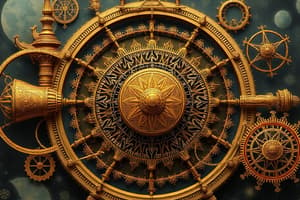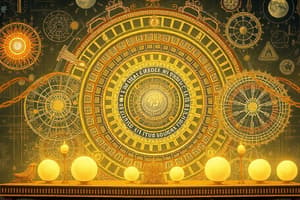Podcast
Questions and Answers
What does Newton's first law of motion state?
What does Newton's first law of motion state?
According to the first law of thermodynamics, what does the change in internal energy equal?
According to the first law of thermodynamics, what does the change in internal energy equal?
What does the second law of thermodynamics state about entropy?
What does the second law of thermodynamics state about entropy?
What principle does Faraday's law illustrate?
What principle does Faraday's law illustrate?
Signup and view all the answers
What is kinetic energy defined as?
What is kinetic energy defined as?
Signup and view all the answers
Which of the following correctly states Coulomb's law?
Which of the following correctly states Coulomb's law?
Signup and view all the answers
What do electromagnetic waves consist of?
What do electromagnetic waves consist of?
Signup and view all the answers
In the context of mechanics, what does work involve?
In the context of mechanics, what does work involve?
Signup and view all the answers
What is the phenomenon called when light bends as it passes from one medium to another?
What is the phenomenon called when light bends as it passes from one medium to another?
Signup and view all the answers
Which principle states that it is impossible to know both the position and momentum of a particle with perfect accuracy simultaneously?
Which principle states that it is impossible to know both the position and momentum of a particle with perfect accuracy simultaneously?
Signup and view all the answers
In the context of special relativity, what term describes the phenomenon where time appears to move slower for an object in motion compared to one at rest?
In the context of special relativity, what term describes the phenomenon where time appears to move slower for an object in motion compared to one at rest?
Signup and view all the answers
What does the equation E=mc² illustrate in the context of relativity?
What does the equation E=mc² illustrate in the context of relativity?
Signup and view all the answers
Which phenomenon involves the spreading of light as it passes through an aperture or around an obstacle?
Which phenomenon involves the spreading of light as it passes through an aperture or around an obstacle?
Signup and view all the answers
Signup and view all the answers
Study Notes
Classical Mechanics
- Classical mechanics describes the motion of macroscopic objects.
- It focuses on forces and their effects on motion.
- Key concepts include: Newton's laws of motion, energy, momentum, and work.
- Newton's first law (inertia): An object at rest stays at rest, and an object in motion stays in motion with the same speed and in the same direction unless acted upon by an unbalanced force.
- Newton's second law: Force equals mass times acceleration (F=ma). This law describes how forces cause changes in motion.
- Newton's third law (action-reaction): For every action, there is an equal and opposite reaction.
- Conservation of momentum: In a closed system, the total momentum remains constant.
- Potential energy is energy stored in a system due to its position or configuration. Kinetic energy is energy of motion.
- Work is done when a force causes displacement.
Thermodynamics
- Thermodynamics deals with heat, temperature, and energy transfer.
- Key concepts include: heat, temperature, specific heat, phase transitions, entropy, and the laws of thermodynamics.
- Zeroth law of thermodynamics: If two systems are in thermal equilibrium with a third system, they are in thermal equilibrium with each other.
- First law of thermodynamics: Energy cannot be created or destroyed, only transformed. Change in internal energy = heat added - work done.
- Second law of thermodynamics: The total entropy of an isolated system can only increase over time.
- Third law of thermodynamics: The entropy of a perfect crystal at absolute zero is zero.
- Heat transfer mechanisms include conduction, convection, and radiation.
Electromagnetism
- Electromagnetism describes the interactions between electric charges and magnetic fields.
- Key concepts include: electric charge, electric field, electric potential, magnetic field, and electromagnetic waves.
- Coulomb's law describes the force between two point charges.
- Electric fields are created by electric charges.
- Electric potential is the electric potential energy per unit charge.
- Magnetic fields are created by moving charges or currents.
- Faraday's law describes how a changing magnetic field can create an electric field.
- Ampere's law describes how an electric current creates a magnetic field.
- Electromagnetic waves are transverse waves that consist of oscillating electric and magnetic fields.
Optics
- Optics deals with the behavior of light.
- Key concepts include: reflection, refraction, lenses, mirrors, diffraction, and interference.
- Reflection is the bouncing of light off a surface.
- Refraction is the bending of light as it passes from one medium to another.
- Lenses and mirrors can focus or disperse light.
- Diffraction is the spreading of light as it passes through an aperture or around an obstacle.
- Interference is the superposition of light waves.
Quantum Mechanics
- Quantum mechanics describes the behavior of matter and energy at the atomic and subatomic level.
- Key concepts include: quantization of energy, wave-particle duality, uncertainty principle, quantum numbers, and probability.
- Energy is quantized, meaning it can only exist in discrete values.
- Wave-particle duality implies that particles can exhibit wave-like properties and vice-versa.
- The Heisenberg Uncertainty Principle states that it is impossible to know both the position and momentum of a particle with perfect accuracy simultaneously.
- Quantum numbers describe the properties of atomic orbitals.
Relativity
- Relativity describes the relationship between space and time and their connection to gravity and motion.
- Key concepts include: special relativity and general relativity.
- Special relativity deals with the motion of objects at constant velocities.
- General relativity describes gravity as a curvature of spacetime caused by mass and energy.
- Key concepts in special relativity: time dilation, length contraction, and the equivalence of mass and energy (E=mc²).
Studying That Suits You
Use AI to generate personalized quizzes and flashcards to suit your learning preferences.
Description
Test your knowledge on classical mechanics and thermodynamics. This quiz covers fundamental concepts such as Newton's laws of motion, energy types, and the principles of heat and energy transfer. Challenge yourself to see how well you understand these essential topics in physics.




